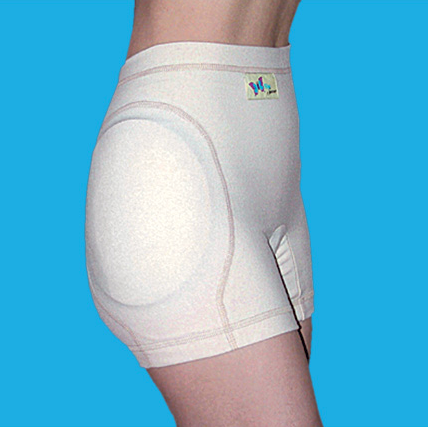Have you fallen yet? Up to one third of seniors fall down at some point and falls are the direct cause of 95% of hip fractures. One third of those who fall are discharged directly to long term care and of the remainder, a high percentage will require care in order to remain in their homes. Preventing the fall in the first place is the best practice. Check out our home safety checklists to ‘senior proof’ your home.
Among the interventions that can be easily accessed is a hip protector. While there are several brands on the market worldwide, extensive tests conducted at Simon Fraser University and led Canada’s largest health authority, Fraser Health Authority, to choose two brands for use in their long term care and acute care facilities and also to recommend to community dwellers. Based on their efficacy, existing clinical studies and range of available models, HipSaver Hip Protectors and SafeHip Hip Protectors are the two brands purchased by FHA. Many other health authorities across the country have followed FHA’s lead, if not by policy then by practice.
Hip protectors are not something one wakes up one morning and considers going out to purchase. Typically, a fall has led to medical consultations which result in several adjustments in one’s life meant to keep aging seniors safe. Among the adjustments is typically the addition of a hip protector to the wardrobe. With hip pads made of materials designed to absorb and/or distribute the energy produced in a fall rather than allow it through to the hip possibly causing a fracture, hip protectors are far more discreet than they were when first introduced. The materials are so soft that the hip protectors can easily be worn while sleeping. Most people’s greatest fear is that they will look different, that others will be able to tell that hip protectors are being worn. For those who are not wearing incontinence briefs, the hip protector models available are as discreet as possible with the fabric cut shaped to the human body and the pads designed with tapered edges. HipSaver Canada distributor, Karen Brown, tells us that she once gave a presentation to 150 women at a church meeting and nobody could tell that one of them was wearing hip protectors. “I secretly asked one of the ladies to wear a HipSaver SlimFit throughout the lunch and meeting. This lady is a tall, thin woman who wore black trousers with a tucked in blouse and an unbuttoned sweater,” says Brown, “and when I asked them to guess who was wearing the HipSavers they all began checking each other out. In the end, they were surprised to discover who the model was and, of course, they all had to touch her hips to make sure we weren’t fooling them!”
While it is difficult to convince community dwelling seniors to take many of the steps necessary to prevent being compelled to enter long term care, as our communities age more and more of them will see that they aren’t alone and agree to many of the required interventions. For most, staying in their homes as long as possible is the ultimate goal. The use of hip protectors is a best practice standard of the Registered Nurse’s Association of Ontario however the RNAO doesn’t name brands. Because they aren’t regulated, hip protectors take many forms and are made of different materials so you want to make sure to check the following:
- Does the brand have clinical trial material available that names that brand specifically rather than hip protectors in general?
- Does the particular brand have biomechanics tests available that name the brand? This will show you how much energy can be absorbed by that hip pad.
- Can the hip protector be washed and dried in temperatures hot enough to kill bacteria? Cold water and gentle dry cycle won’t do the trick.
- Are there options such as tailbone protection available?
- Are there an adequate number of models available to suit your lifestyle and challenges?
- Are there an adequate number of sizes available? The hip pads shouldn’t be able to shift about on your body, so the more sizes, the better.
Do your research before you purchase, follow the advice of the independent researchers at Simon Fraser University or talk to your medical team to get their advice.






Add Your Voice
0 Comments
Join the Discussion